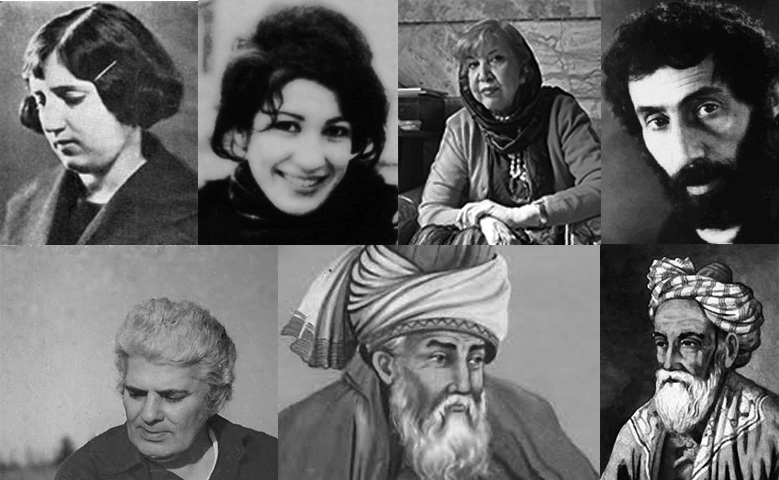
For centuries, Iran has been producing some of the world’s most influential and inspiring poets, whose works revolutionized the literature of both the East and the West. Spanning themes of love, pine mysticism and human rights, their poetry is an incredible contribution to Iranian culture, and remains entirely relevant today. Here we profile 10 of the most inspiring Iranian poets.
1. Ahmad Shamloo
Ahmad Shamloo (1925–2000) is most remembered as a pioneer of Farsi free verse poetry, but his various literary contributions as a journalist, translator, and children’s writer left him as a highly praised but controversial figure in twentieth-century Iranian literature.
Widely considered to be the forefather of modern Iranian poetry, Ahmad Shamloo was one of the first poets to abandon the strict classical style of previous poetry and instead employ a free style and structure. What makes his work so complex, however, is his continued use of allusions and references to traditional, beloved Iranian poets such as Khayyam and Hafez. His poems thereby become an intersection of the past and present, using old, familiar imagery in new forms to create innovative, yet culturally relevant and personal poetry. Shamloo also wrote the Book of Alley, an enormously influential 13-volume work which compiles and reviews the history of Iranian folklore.
2. Sohrab Sepheri
There Is No Cloud
There is no cloud,
There is no wind,
I sit beside the pond,
The swimming fishes, light, I, flower, water,
The pureness of the cluster of life;
My mother reaps the sweet basil,
Bread, sweet basil, cheese, a cloudless sky, wet garden petunia,
Salvation is at hand: within the garden flowers.Over the foot-bath in a copper bowl, what caresses the light pours,
The ladder at the garden corner, brings morning on earth,
A smile hides behind everything,
The time’s wall has a hole through which my face is seen;
There are things which I don’t know;
I know that I will die if I cut away a leaf,
I ascend, rise to the peak, I posses wings and feathers,
I can see in the darkness, I’m brimful of lanterns,
I’m brimful of cloud and earth,
I’m brimful of sun and sand,
I’m brimful of vines,
I’m brimful of path, of bridge, of river, of wave,
I’m brimful of the shadows of reeds in the water,
I’m brimful of the movement of that willow tree at the garden’s end.
How my inside is empty.
One of Iran’s most influential poets of recent times, Sohrab Sepheri revolutionised Iranian poetry with what became termed as ‘New Poetry’ – a form of modernist writing which ignored the metre, rhyme and structure of classical verse in favour of new, unconstrained forms. Sepheri married Western poetic traits with traditional Eastern ones, thereby creating a fresh new style and perspective through which his ideas could be presented. Although not shockingly political or subversive, Sepheri’s poetry remains challenging, questioning pervasive social and ideological norms and advocating for new perspectives which positively embrace all of humanity.
3. Forough Farrokhzad
Forough Farrokhzad’s poetry is an expression of defiance and resistance. Herself a controversial figure – she porced her husband in her early twenties and had a wide range of male friends with whom she unashamedly spent great amounts of time – her poetry too became controversial for its bold, female voice and its harsh criticism of the position of women in Iranian society. Farrokhzad’s poetry does not flinch away from depicting emotion, rather the author’s feelings and passions are unapologetically present, making her work not only politically engaging, but intensely personal. Through her writing, Farrokhzad became a voice for women on both a general and inpidual level.
4. Simin Behbahani
The daughter of two poets, Simin Behbahani was surrounded by literature and verse from a young age, and began writing her own poems before she became a teenager. Nominated twice for the Nobel Prize for Literature, Behbahani is remarkable for her incredible influence both in Iranian poetry circles and in issues of human rights; her poetry is highly political, reflecting her strong feminist views and critique of society under both the Shah and the Islamic Republic. Exposing the tragedy of poverty, prejudice, and war – in particular the Iran-Iraq war – Behbahani’s poetry is a voice for the oppressed and marginalised in Iran.
5. Parvin Etesami
One of Iran’s most prominent female poets, Parvin Etesami began writing poetry from a young age; her first published works appeared in the Iranian magazine Bahar in the early 1920s, when she was just a teenager. Throughout her life, Etesami’s work was a marriage of the traditional and modern; while her poetic style eschewed the new modernist styles and adhered closely to the forms and structures of classical Persian poetry, in particular its ghazals, the content of her writing remained decidedly contemporary, discussing the problems of Iranian society at the time. Through beautiful allegories and imagery revolving around nature and other typical motifs, Etesami exposed issues of women’s right, poverty and social injustice.
6. Ferdowsi
Ferdowsi is perhaps Iran’s most famous poet, credited for writing the Shahnameh, the national epic of the Persian speaking world and the longest work of epic poetry ever written, composed of over 60,000 verses. Translated as ‘The Book of Kings’, the Shahnameh spans the history of Iran from mythical times until the Sassanid period in the 7th century, telling the tales of heroic blacksmiths, despotic rulers and wicked demons who form the currents of good and evil which run throughout human history. Through his complex characters, Ferdowsi demonstrates the capacity for lightness and darkness and for happiness and unhappiness, in every being, encouraging his readers to actively take the side of good.
7. Nizami Ganjavi
One of the greatest romantic poets of all time, Nizami Ganjavi had a powerful and unique effect on Iranian literature. He is most famous for his long narrative poems revolving around themes of love and passion, such as Khosrow and Shirin or Leyla and Majnun, both of which are culturally comparable to Romeo and Juliet in the English-speaking world. Ganjavi is notable for uniting the long narrative epic form, usually associated with tales of heroism or mysticism, with tales of human emotion and passion, thereby revolutionising the genre. Written in beautifully lyrical, courtly language, Ganjavi’s poetry uplifts and glorifies the concept of love, validating its presence in poetry alongside ideas of the pine.
8. Hafez
O beautiful wine-bearer, bring forth the cup and put it to my lips
Path of love seemed easy at first, what came was many hardships.
With its perfume, the morning breeze unlocks those beautiful locks
The curl of those dark ringlets, many hearts to shreds strips.
In the house of my Beloved, how can I enjoy the feast
Since the church bells call the call that for pilgrimage equips.
With wine color your robe, one of the old Magi’s best tips
Trust in this traveler’s tips, who knows of many paths and trips.
The dark midnight, fearful waves, and the tempestuous whirlpool
How can he know of our state, while ports house his unladen ships.
I followed my own path of love, and now I am in bad repute
How can a secret remain veiled, if from every tongue it drips?
If His presence you seek, Hafiz, then why yourself eclipse?
Stick to the One you know, let go of imaginary trips.
A hugely influential poet, Hafez went on to inspire generations of new poets both in Iran and in the wider world, including Goethe, who wrote his poetry collection the West-östlicher Diwan as a tribute to Hafez and his style. Hafez is known for his unique blend of the mystical and the human, blending representations of both pine and romantic love in verses filled with elaborate metaphors and vivid imagery which convey multiple meanings. Today, his marble tomb stands underneath a beautifully tiled pavilion in the Musalla Gardens in Shiraz and is one of the city’s greatest tourist attractions, with thousands of fans and admirers coming to pay their respects.
9. Omar Khayyam
Awake! for Morning in the Bowl of Night
Has flung the Stone that puts the Stars to Flight:
And Lo! the Hunter of the East has caught
The Sultan’s Turret in a Noose of Light.
Born in 11th century Iran, Omar Khayyam was a greatly influential intellectual figure, whose works spanned the fields of astronomy, mathematics, philosophy and poetry. During his lifetime, Khayyam was best known for his work in the former subjects – his treatise on algebra proved hugely important in mathematical circles for centuries while the modern Iranian calendar is based on his research in astronomy. It wasn’t until the 19th century that his poetry was rediscovered and translated by Edward Fitzgerald, introducing his work both to a Western audience and to a new generation of Iranians. Khayyam’s poetry is filled with sensuality, exploring the simultaneous beauty and fragility of life.
10. Rumi
In your light, I learn how to love
in your beauty, how to make poems.You dance inside my chestwhere no one sees you,but sometimes I doand that sight becomes this art.
Not only one of the most popular poets in Iran, but one of the most influential poets worldwide, Rumi’s poetry has inspired other writers and readers for centuries. His work is largely spiritual, stemming from his Sufi beliefs and his position as an important spiritual teacher and leader. Revolving around ideas of universality, pinity and love in all its manifestations, Rumi’s verses are astonishingly insightful, and made all the more powerful by their intense lyricism and beauty of expression. One of his most famous works, The Masnavi, is a collection of over 25,000 verses filled with tales, moral discourses and analogies which explore the relationship between the self and God.
source: theculturetrip

